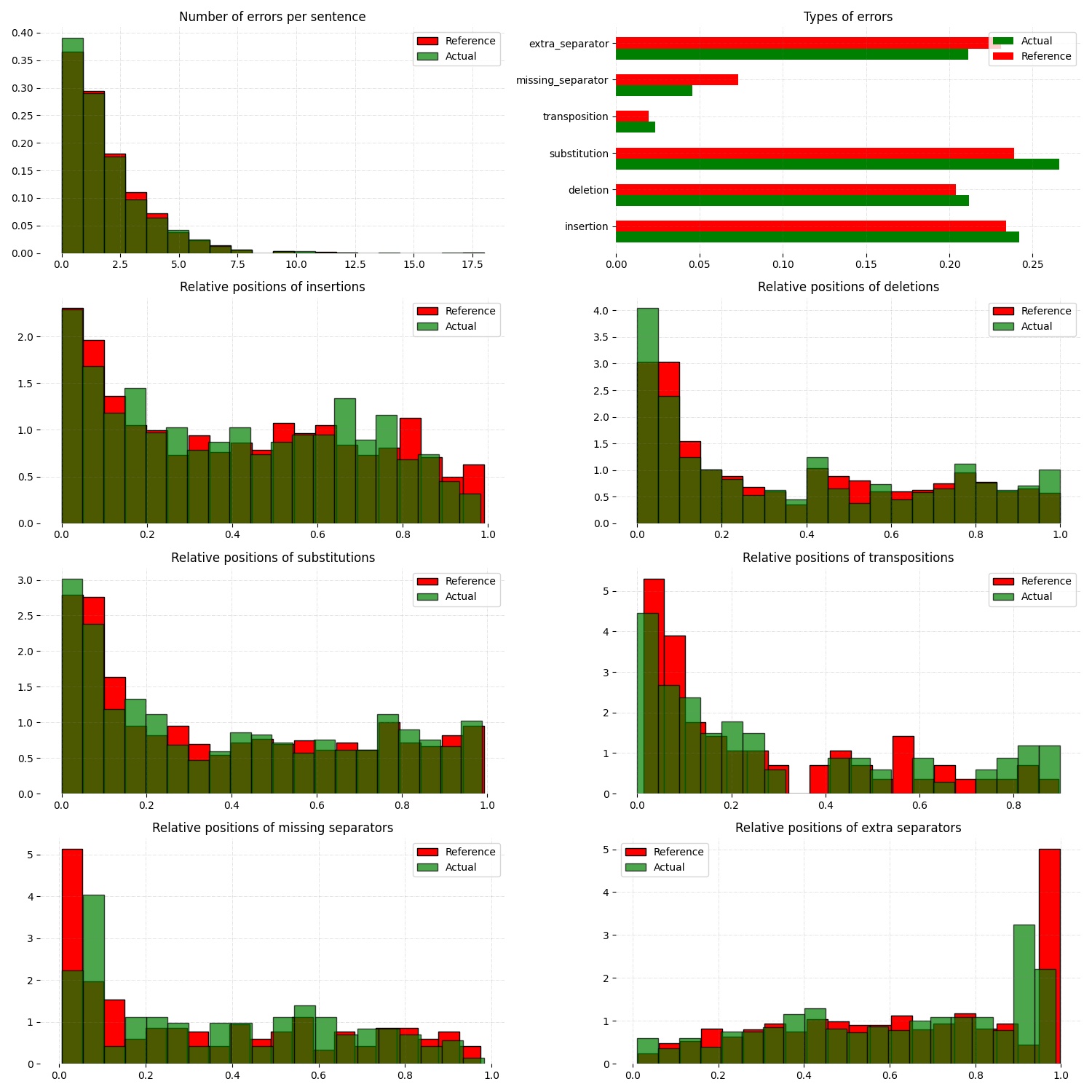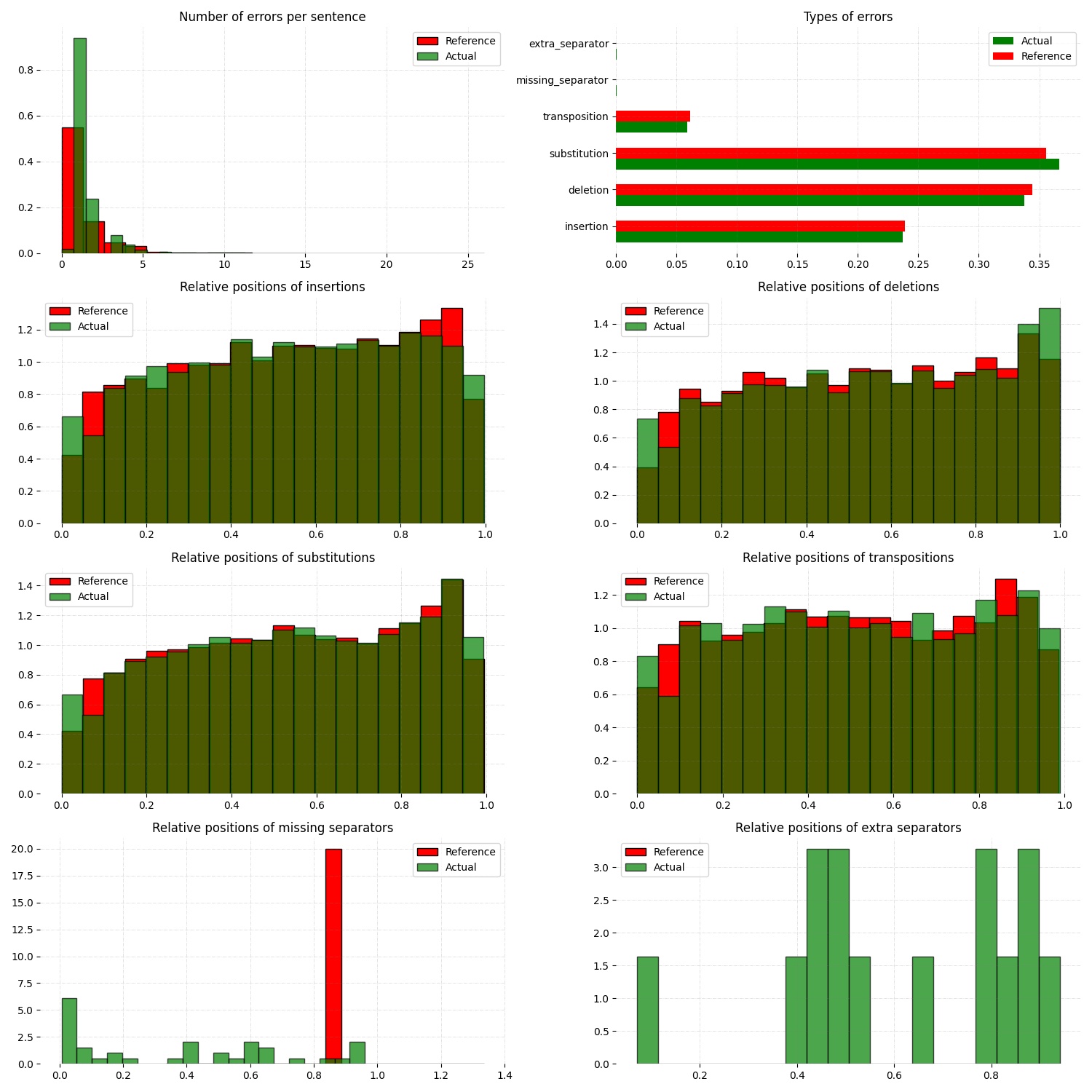多语言拼写纠正、错误生成和评估
SAGE(通过增强和生成分布模拟的拼写检查)是处理拼写问题时所需的完整解决方案:
-
💯 使用最先进的预训练🤗Transformer模型进行拼写纠正:
-
📊 评估拼写纠正工具的性能。
新闻
🔥 [2024-01-18]:我们的论文《通过多领域和多语言自然拼写错误模拟的生成式拼写纠正方法》被EACL 2024会议接受!
💥 [2024-04-11]:SAGE v1.1.0终于发布:关于此次发布详情的综合说明可以在这里找到。
目录
安装
常规安装
git clone https://github.com/ai-forever/sage.git
cd sage
pip install .
要安装使用ERRANT-based指标时需要的额外要求,请运行
pip install -e ".[errant]"
或者只需
pip install -e .[errant]
可编辑安装
git clone https://github.com/ai-forever/sage.git
cd sage
pip install -e .
然后按上述方式安装额外要求。
快速演示
让我们生成一些错误文本:
import sage
from sage.spelling_corruption import SBSCConfig, SBSCCorruptor
from sage.utils import DatasetsAvailable
text = "Заметьте, не я это предложил!"
# 从一个包含医疗病历错误的数据集实例化SBSC错误生成器
config = SBSCConfig(
reference_dataset_name_or_path=DatasetsAvailable.MedSpellchecker.name,
reference_dataset_split="test"
)
corruptor = SBSCCorruptor.from_config(config)
corruptor.corrupt(text, seed=1)
# 'Заиетьте, не я эт о пред ложил!'
... 现在使用Augmentex:
import sage
from sage.spelling_corruption import WordAugConfig, WordAugCorruptor
text = "Заметьте, не я это предложил!"
# 使用自定义参数集实例化WordAugCorruptor错误生成器
config = WordAugConfig(
min_aug=1,
max_aug=5,
unit_prob=0.4,
)
corruptor = WordAugCorruptor.from_config(config)
corruptor.corrupt(text, seed=1)
# 'это не предложил! Заметьте, я'
... 或者对英语:
import os
from sage.spelling_corruption import SBSCConfig, SBSCCorruptor
text = "Screw you guys, I am going home. (c)"
# 从JFLEG数据集实例化SBSC错误生成器
config = SBSCConfig(
lang="en",
reference_dataset_name_or_path=os.path.join("data", "example_data", "jfleg"),
)
corruptor = SBSCCorruptor.from_config(config)
corruptor.corrupt(text, seed=1)
# 'Screw you kuys, I am going home. (c)'
现在我们可以使用我们的模型将初始文本恢复:
from sage.spelling_correction import AvailableCorrectors
from sage.spelling_correction import RuM2M100ModelForSpellingCorrection, T5ModelForSpellingCorruption
text_ru = "Замтьте не я это предложил"
text_en = "Screw you kuys, I am going home. (c)"
corrector_fred = T5ModelForSpellingCorruption.from_pretrained(AvailableCorrectors.sage_fredt5_large.value)
corrector_m2m = RuM2M100ModelForSpellingCorrection.from_pretrained(AvailableCorrectors.m2m100_1B.value)
corrector_en = T5ModelForSpellingCorruption.from_pretrained(AvailableCorrectors.ent5_large.value)
print(corrector_fred.correct(text_ru))
# ['Заметьте, не я это предложил.']
print(corrector_m2m.correct(text_ru))
# ['Заметьте не я это предложил']
print(corrector_en.correct(text_en, prefix="grammar: "))
# ['Screw you guys, I am going home. (c)']
在开放的拼写纠正基准测试上评估模型性能:
import os
import torch
from sage.utils import DatasetsAvailable
from sage.spelling_correction import AvailableCorrectors
from sage.spelling_correction import T5ModelForSpellingCorruption
corrector_fred_95m = T5ModelForSpellingCorruption.from_pretrained(AvailableCorrectors.sage_fredt5_distilled_95m.value)
corrector_mt5 = T5ModelForSpellingCorruption.from_pretrained(AvailableCorrectors.sage_mt5_large.value)
corrector_fred_95m.model.to(torch.device("cuda:0"))
corrector_mt5.model.to(torch.device("cuda:0"))
metrics = corrector_fred_95m.evaluate("RUSpellRU", metrics=["errant", "ruspelleval"], batch_size=32)
print(metrics)
# {'CASE_Precision': 94.41, 'CASE_Recall': 92.55, 'CASE_F1': 93.47, 'SPELL_Precision': 77.52, 'SPELL_Recall': 64.09, 'SPELL_F1': 70.17, 'PUNCT_Precision': 86.77, 'PUNCT_Recall': 80.59, 'PUNCT_F1': 83.56, 'YO_Precision': 46.21, 'YO_Recall': 73.83, 'YO_F1': 56.84, 'Precision': 83.48, 'Recall': 74.75, 'F1': 78.87}
metrics = corrector_mt5.evaluate("/content/sage/data/example_data/jfleg", metrics=["ruspelleval"], batch_size=16)
print(metrics)
# {'Precision': 75.94, 'Recall': 88.15, 'F1': 81.59}
注意:如果你在Colab中运行代码片段,你可能会遇到内存错误,所以要管理评估过程以满足可用设备的限制。作为可行的解决方法,你可以执行
del corrector_fred_95m.model
来释放一些空间。
拼写错误生成
我们实现了两种拼写错误生成方法。基于统计的拼写错误生成(SBSC)旨在模仿人类在犯错时的行为。而Augmentex则依赖于基于规则的启发式方法和常见错误,特别是在使用键盘输入文本时所犯的错误。
🚀 这两种方法都证明了它们对拼写纠正系统的有效性,并取得了显著的性能提升,详细报告见我们的论文。
基于统计的拼写错误生成(SBSC)
简而言之,SBSC遵循两个简单步骤:
- 🧠 分析错误,其类型和在源文本中的位置;
- ✏️ 在新句子中复现源文本中的错误;
🧠 为了分析源句子中的错误,我们需要其相应的纠正,以构建Levenshtein矩阵,从右下角入口开始反向遍历,并确定错误的确切位置和类型。然后我们汇总所有获得的统计数据,并将其归一化为有效的离散分布。
✏️ "复现"步骤更加简单:我们只需从相应的分布中抽样每个句子的错误数量、类型和相对位置,并将它们应用到正确的句子上。
如前所述,你需要一个平行数据集来"拟合"SBSC。我们提供了一组四个包含自然错误的数据集,涵盖了广泛的领域:
- RUSpellRU: 从LiveJournal收集的文本,手动纠正了拼写错误;
- MultidomainGold: 来自7个文本来源的示例,包括开放网络、新闻、社交媒体、评论、字幕、政策文件和文学作品;
- MedSpellChecker: 来自医疗病史的错误文本;
- GitHubTypoCorpusRu: GitHub提交中的拼写错误和typo;
你可以像这样简单地使用它们:
import sage
from sage.spelling_corruption import SBSCConfig, SBSCCorruptor
from sage.utils import DatasetsAvailable
# 从医疗病史错误数据集实例化SBSC错误生成器
config = SBSCConfig(
reference_dataset_name_or_path=DatasetsAvailable.MedSpellchecker.name,
reference_dataset_split="test"
)
corruptor = SBSCCorruptor.from_config(config)
...或者你可以从本地存储的数据集初始化你的SBSC:
import os
from sage.spelling_corruption import SBSCConfig, SBSCCorruptor
# 从JFLEG数据集实例化SBSC错误生成器
config = SBSCConfig(
lang="en",
reference_dataset_name_or_path=os.path.join("data", "example_data", "jfleg"),
)
corruptor = SBSCCorruptor.from_config(config)
✅ 要检查SBSC实际上近似原始错误的效果如何,你可以绘制原始和合成生成分布的并排图表:


要访问这些图表,你可以简单地:
from sage.utils import load_available_dataset_from_hf, draw_and_save_errors_distributions_comparison_charts
from sage.spelling_corruption.sbsc.labeler import process_mistypings
from sage.spelling_corruption import SBSCCorruptor
sources, corrections = load_available_dataset_from_hf("RUSpellRU", for_labeler=True, split="train")
ruspellru_stats, ruspellru_confusion_matrix, ruspellru_typos_cnt = process_mistypings(sources, corrections)
corruptor = SBSCCorruptor.from_default_config()
spoiled_sentences = corruptor.batch_corrupt(corrections)
sbsc_stats, sbsc_confusion_matrix, sbsc_typos_cnt = process_mistypings(spoiled_sentences, corrections)
draw_and_save_errors_distributions_comparison_charts(
actual_typos_cnt = sbsc_typos_cnt,
reference_typos_cnt=ruspellru_typos_cnt,
actual_stats=sbsc_stats,
reference_stats=ruspellru_stats,
path_to_save="ruspellru_sbsc.jpg"
)
Augmentex
Augmentex引入了基于规则和常见统计(由KartaSlov项目支持)的方法来在文本中插入错误。它再次在论文中有全面描述,也在这个🗣️演讲中有介绍。 🖇️ Augmentex 在文本损坏方面允许你在两个粒度级别上操作,并为特定级别提供了一套特定方法:
- 词级别:
- 替换 - 用不正确的对应词替换随机单词;
- 删除 - 删除随机单词;
- 交换 - 交换两个随机单词;
- 停用词 - 从停用词列表中添加随机单词;
- 反转 - 改变随机单词首字母的大小写;
- 字符级别:
- 移位 - 随机交换字符串中的大小写;
- 拼写错误 - 用常见的错误对应项替换正确字符;
- 打字错误 - 将正确字符替换为键盘上误打的字符;
- 删除 - 删除随机字符;
- 重复 - 重复随机字符;
- 交换 - 交换相邻的两个字符;
- 插入 - 插入随机字符;
要访问 Augmentex,你只需要以下几个操作:
from sage.spelling_corruption import CharAugConfig, CharAugCorruptor
config = CharAugConfig(
unit_prob=0.3, # 将要进行编辑的字符比例
min_aug=1, # 最小编辑次数
max_aug=5, # 最大编辑次数
mult_num=3 # `重复`编辑
)
corruptor = CharAugCorruptor.from_config(config)
... 或者像这样:
from sage.spelling_corruption import WordAugConfig, WordAugCorruptor
config = WordAugConfig(
unit_prob=0.4, # 将要进行编辑的字符比例
min_aug=1, # 最小编辑次数
max_aug=5, # 最大编辑次数
)
corruptor = WordAugCorruptor.from_config(config)
Augmentex 是由我们的团队创建的,该项目有自己的仓库,别忘了去看看!
拼写纠正
我们在拼写检查任务上获得最佳性能模型的方法在我们的论文中有详细描述。算法简单,主要包括两个步骤:
- 在带有人工生成错误的大规模平行语料上预训练模型;
- 在包含"人为"错误的可用拼写纠正数据集组合上进行微调;
我们使用Augmentex和SBSC来生成大规模合成语料库,并增强包含自然错误的数据集。 预训练的纠错器家族现在包含8个模型。
我们有6个用于俄语🇷🇺的🤗Transformer模型:
- sage-fredt5-large
- sage-fredt5-distilled-95m
- sage-m2m100-1.2B
- M2M100-1.2B [早期发布]
- M2M100-418M [早期发布]
- FredT5-large [早期发布]
以及两个用于英语🇬🇧的模型:
俄语模型在俄语维基百科和视频转录的组合上进行了预训练,其中包含由SBSC生成的人工错误,该统计数据来自RUSpellRU的训练集。 英语纠错器在英语维基百科文章和新闻帖子的混合数据上训练,其中包含由SBSC插入的合成错误,该统计数据来自BEA60k的5k子样本。
📚 我们还在可用的"人为"错误数据集上验证我们的解决方案:
- RUSpellRU:从LiveJournal收集的文本,手动纠正了拼写错误;
- MultidomainGold:来自7个文本来源的示例,包括开放网络、新闻、社交媒体、评论、字幕、政策文件和文学作品;
- MedSpellChecker:医疗病历中的错误文本;
- GitHubTypoCorpusRu:GitHub提交中的拼写错误和typo;
- BEA60K:从多个领域收集的英语拼写错误;
- JFLEG:1601个英语句子,包含约2000个拼写错误;
📈 这里我们报告了一些设置的评估结果:
- 预训练检查点的零样本评估;
- 在目标数据集上进行额外的微调(ft.);
完整的设置列表和相应的性能在论文中。
RUSpellRU、MultidomainGold、MedSpellChecker和GitHubTypoCorpusRu来自spellcheck_punctuation_benchmark。 该基准测试同时考虑了标点符号和拼写错误。为了简单和更好的代表性,我们只报告那些处理两种类型错误的模型(俄语)的结果 (sage-fredt5-large,sage-fredt5-distilled-95m)。 其他检查点的详细指标可以在论文、博文或相应的模型卡片中找到。
注意: MedSpellChecker和GitHubTypoCorpusRu没有训练集,所以它们在预训练 + 微调设置下的性能报告是在RUSpellRU和MultidomainGold数据集组合上微调的结果。
RUSpellRU 评估
| 模型 | 精确率 (拼写) | 召回率 (拼写) | F1 (拼写) | 精确率 (标点) | 召回率 (标点) | F1 (标点) | 精确率 (大小写) | 召回率 (大小写) | F1 (大小写) |
|---|---|---|---|---|---|---|---|---|---|
| sage-ai-service | 90.3 | 86.3 | 88.2 | 90.3 | 86.6 | 88.4 | 95.2 | 95.9 | 95.6 |
| sage-fredt5-large | 57.3 | 68.0 | 62.2 | 86.7 | 46.1 | 60.2 | 92.1 | 67.8 | 78.1 |
| sage-fredt5-large (ft.) | 88.4 | 80.9 | 84.5 | 88.2 | 85.3 | 86.8 | 95.5 | 94.0 | 94.7 |
| sage-fredt5-distilled-95m (ft.) | 83.5 | 74.8 | 78.9 | 86.8 | 80.6 | 83.6 | 94.4 | 92.5 | 93.5 |
| gpt-3.5-turbo | 33.6 | 58.5 | 42.7 | 85.9 | 64.6 | 73.7 | 84.9 | 73.9 | 79.0 |
| gpt-4 | 54.9 | 76.7 | 64.0 | 84.0 | 82.3 | 83.2 | 91.5 | 90.2 | 90.9 |
MultidomainGold 评估
| 模型 | 准确率 (拼写) | 召回率 (拼写) | F1值 (拼写) | 准确率 (标点) | 召回率 (标点) | F1值 (标点) | 准确率 (大小写) | 召回率 (大小写) | F1值 (大小写) |
|---|---|---|---|---|---|---|---|---|---|
| sage-ai-service | 81.6 | 77.7 | 79.6 | 70.2 | 67.5 | 68.8 | 80.5 | 80.5 | 80.5 |
| sage-fredt5-large | 43.4 | 49.7 | 46.3 | 21.8 | 21.3 | 21.6 | 58.8 | 23.9 | 34.0 |
| sage-fredt5-large (微调) | 80.3 | 75.1 | 77.6 | 69.0 | 66.5 | 67.7 | 78.6 | 80.0 | 79.3 |
| sage-fredt5-distilled-95m (微调) | 77.2 | 69.9 | 73.4 | 66.8 | 63.4 | 65.0 | 76.8 | 79.1 | 77.9 |
| gpt-3.5-turbo | 18.8 | 48.1 | 27.1 | 42.0 | 31.8 | 36.2 | 47.1 | 51.3 | 49.1 |
| gpt-4 | 25.4 | 68.0 | 37.0 | 57.8 | 54.3 | 56.0 | 54.0 | 67.5 | 60.0 |
MedSpellchecker 评估
| 模型 | 准确率 (拼写) | 召回率 (拼写) | F1值 (拼写) | 准确率 (标点) | 召回率 (标点) | F1值 (标点) | 准确率 (大小写) | 召回率 (大小写) | F1值 (大小写) |
|---|---|---|---|---|---|---|---|---|---|
| sage-ai-service | 71.3 | 73.5 | 72.4 | 75.1 | 69.2 | 72.0 | 80.9 | 72.8 | 76.6 |
| sage-fredt5-large | 35.2 | 54.5 | 42.8 | 19.2 | 13.2 | 15.7 | 48.7 | 36.8 | 41.9 |
| sage-fredt5-large (微调) | 72.5 | 72.2 | 72.3 | 74.6 | 66.4 | 70.3 | 79.3 | 85.1 | 82.1 |
| sage-fredt5-distilled-95m (微调) | 65.1 | 64.8 | 64.9 | 78.6 | 63.1 | 70.0 | 63.5 | 74.7 | 68.7 |
| gpt-3.5-turbo | 14.7 | 45.9 | 22.3 | 69.9 | 52.3 | 59.8 | 26.4 | 41.8 | 32.3 |
| gpt-4 | 37.8 | 72.3 | 49.6 | 81.4 | 64.3 | 71.9 | 73.0 | 62.1 | 67.1 |
GitHubTypoCorpusRu 评估
| 模型 | 准确率 (拼写) | 召回率 (拼写) | F1值 (拼写) | 准确率 (标点) | 召回率 (标点) | F1值 (标点) | 准确率 (大小写) | 召回率 (大小写) | F1值 (大小写) |
|---|---|---|---|---|---|---|---|---|---|
| sage-ai-service | 70.8 | 56.3 | 62.7 | 48.9 | 35.8 | 41.4 | 32.9 | 45.3 | 38.1 |
| sage-fredt5-large | 46.0 | 46.6 | 46.3 | 22.7 | 18.3 | 20.2 | 12.0 | 13.2 | 12.6 |
| sage-fredt5-large (微调) | 67.5 | 53.2 | 59.5 | 48.5 | 38.0 | 42.6 | 37.3 | 50.0 | 42.7 |
| sage-fredt5-distilled-95m (微调) | 57.8 | 48.5 | 52.7 | 45.2 | 39.5 | 42.1 | 29.9 | 46.2 | 36.3 |
| gpt-3.5-turbo | 23.7 | 38.7 | 29.4 | 37.6 | 23.3 | 28.7 | 19.6 | 35.9 | 25.3 |
| gpt-4 | 27.0 | 52.8 | 35.7 | 45.9 | 32.6 | 38.2 | 25.7 | 36.8 | 30.2 |
BEA60K 评估
| 模型 | 准确率 | 召回率 | F1值 |
|---|---|---|---|
| sage-mt5-large | 64.7 | 83.8 | 73.0 |
| T5-large-spell | 66.5 | 83.1 | 73.9 |
| gpt-3.5-turbo | 66.9 | 84.1 | 74.5 |
| gpt-4 | 68.6 | 85.2 | 76.0 |
| Bert | 65.8 | 79.6 | 72.0 |
| SC-LSTM | 62.2 | 80.3 | 72.0 |
JFLEG 评估
| 模型 | 准确率 | 召回率 | F1值 |
|---|---|---|---|
| sage-mt5-large | 74.9 | 88.4 | 81.1 |
| T5-large-spell | 83.4 | 84.3 | 83.8 |
| gpt-3.5-turbo | 77.8 | 88.6 | 82.9 |
| gpt-4 | 77.9 | 88.3 | 82.8 |
| Bert | 78.5 | 85.4 | 81.8 |
| SC-LSTM | 80.6 | 86.1 | 83.2 |
RUSpellRU、MultidomainGold、MedSpellChecker 和 GitHubTypoCorpusRu 在 HuggingFace 上作为数据集提供,也可以通过我们库的 API 获取:
from sage.utils import load_available_dataset_from_hf, DatasetsAvailable
print([dataset.name for dataset in DatasetsAvailable])
# ['MultidomainGold', 'RUSpellRU', 'MedSpellchecker', 'GitHubTypoCorpusRu', 'MultidomainGold_orth', 'RUSpellRU_orth', 'MedSpellchecker_orth', 'GitHubTypoCorpusRu_orth']
gold_dataset = load_available_dataset_from_hf(DatasetsAvailable.MultidomainGold.name, for_labeler=False)
print(len(gold_dataset))
# 7675
sources, corrections = load_available_dataset_from_hf(DatasetsAvailable.RUSpellRU.name, for_labeler=True, split="train")
print(len(sources), len(corrections))
# 2000 2000
评估
我们还提供功能来评估拼写纠正系统的性能并对它们进行排名。
🎯 目前有两个可用选项:
- ruspelleval;
- 为俄语改编的基于 ERRANT 的指标;
这两种算法都会输出准确率、召回率和 F1 值,可以解释如下:
- 准确率:1 减去不必要修正的比例;
- 召回率:预期纠正的比例;
- F1 值:上述两个指标的著名几何平均值; 你可以通过以下方式简单获取这些指标:
from sage.evaluation import Scorer
from sage.utils import DatasetsAvailable, load_available_dataset_from_hf
sources, corrections = load_available_dataset_from_hf(DatasetsAvailable.RUSpellRU.name, for_labeler=True, split="test")
scorer = Scorer()
metrics = scorer.score(sources, corrections, corrections, metrics=["ruspelleval", "errant"])
print(metrics)
# {'Precision': 100.0, 'Recall': 100.0, 'F1': 100.0, 'CASE_Precision': 100.0, 'CASE_Recall': 100.0, 'CASE_F1': 100.0, 'SPELL_Precision': 100.0, 'SPELL_Recall': 100.0, 'SPELL_F1': 100.0, 'PUNCT_Precision': 100.0, 'PUNCT_Recall': 100.0, 'PUNCT_F1': 100.0, 'YO_Precision': 100.0, 'YO_Recall': 100.0, 'YO_F1': 100.0}
... 或者直接评估模型:
import os
import torch
from sage.utils import DatasetsAvailable
from sage.spelling_correction import AvailableCorrectors
from sage.spelling_correction import T5ModelForSpellingCorruption
corrector_fred_95m = T5ModelForSpellingCorruption.from_pretrained(AvailableCorrectors.sage_fredt5_distilled_95m.value)
corrector_mt5 = T5ModelForSpellingCorruption.from_pretrained(AvailableCorrectors.sage_mt5_large.value)
corrector_fred_95m.model.to(torch.device("cuda:0"))
corrector_mt5.model.to(torch.device("cuda:0"))
metrics = corrector_fred_95m.evaluate("RUSpellRU", metrics=["errant", "ruspelleval"], batch_size=32)
print(metrics)
# {'CASE_Precision': 94.41, 'CASE_Recall': 92.55, 'CASE_F1': 93.47, 'SPELL_Precision': 77.52, 'SPELL_Recall': 64.09, 'SPELL_F1': 70.17, 'PUNCT_Precision': 86.77, 'PUNCT_Recall': 80.59, 'PUNCT_F1': 83.56, 'YO_Precision': 46.21, 'YO_Recall': 73.83, 'YO_F1': 56.84, 'Precision': 83.48, 'Recall': 74.75, 'F1': 78.87}
metrics = corrector_mt5.evaluate("/content/sage/data/example_data/jfleg", metrics=["ruspelleval"], batch_size=16)
print(metrics)
# {'Precision': 75.94, 'Recall': 88.15, 'F1': 81.59}
基于ERRANT算法输出的指标由相应的前缀指示,这些前缀指的是特定类型的错误:
- CASE:错误使用的大小写;
- SPELL:拼写和语法错误;
- PUNCT:标点符号错误;
- YO:不必要地替换"YO"(ё)字母;
📌 ruspelleval指标的评估脚本归功于Aleksei Sorokin及其在SpellRueval会议论文集中的杰出工作。
引用
如果你想了解更多关于我们工作的信息,请查看以下出版物:
💥 我们的EACL 2024论文详细描述了获得拼写纠正SOTA模型的方法,以及所有进行的实验的全面报告。
💫 而我们的Dialogue-2023论文则侧重于利用拼写纠正任务的资源和获取高质量平行语料库的程序。
@inproceedings{martynov-etal-2024-methodology,
title = "A Methodology for Generative Spelling Correction via Natural Spelling Errors Emulation across Multiple Domains and Languages",
author = "Martynov, Nikita and
Baushenko, Mark and
Kozlova, Anastasia and
Kolomeytseva, Katerina and
Abramov, Aleksandr and
Fenogenova, Alena",
editor = "Graham, Yvette and
Purver, Matthew",
booktitle = "Findings of the Association for Computational Linguistics: EACL 2024",
month = mar,
year = "2024",
address = "St. Julian{'}s, Malta",
publisher = "Association for Computational Linguistics",
url = "https://aclanthology.org/2024.findings-eacl.10",
pages = "138--155",
abstract = "Large language models excel in text generation and generalization, however they face challenges in text editing tasks, especially in correcting spelling errors and mistyping.In this paper, we present a methodology for generative spelling correction (SC), tested on English and Russian languages and potentially can be extended to any language with minor changes. Our research mainly focuses on exploring natural spelling errors and mistyping in texts and studying how those errors can be emulated in correct sentences to enrich generative models{'} pre-train procedure effectively. We investigate the effects of emulations in various text domains and examine two spelling corruption techniques: 1) first one mimics human behavior when making a mistake through leveraging statistics of errors from a particular dataset, and 2) second adds the most common spelling errors, keyboard miss clicks, and some heuristics within the texts.We conducted experiments employing various corruption strategies, models{'} architectures, and sizes in the pre-training and fine-tuning stages and evaluated the models using single-domain and multi-domain test sets. As a practical outcome of our work, we introduce SAGE (Spell checking via Augmentation and Generative distribution Emulation).",
}
@inproceedings{martynov2023augmentation,
title={Augmentation methods for spelling corruptions},
author={Martynov, Nikita and Baushenko, Mark and Abramov, Alexander and Fenogenova, Alena},
booktitle={Proceedings of the International Conference "Dialogue},
volume={2023},
year={2023}
}
📌 如果你有任何关于我们工作的问题,请随时与相应的联系人联系:

 Github
Github Huggingface
Huggingface 文档
文档 论文
论文











